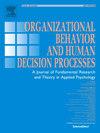The double-edged sword of endorsing external ideas: Juggling competitive advantage and organizational compatibility concerns
IF 3.8
2区 管理学
Q2 MANAGEMENT
Organizational Behavior and Human Decision Processes
Pub Date : 2025-05-27
DOI:10.1016/j.obhdp.2025.104417
引用次数: 0
Abstract
In spurring employee innovation, organizations often encourage employees to seek creative ideas from external sources. However, research findings on managers’ receptivity to external ideas are mixed. While some work suggests that managers are favorable towards external ideas, other studies indicate that they often exhibit a “not-invented-here” syndrome, a negative attitude towards external ideas. Drawing from Dynamic Capabilities Theory and integrating it with the managerial creativity endorsement literature, we develop a dual-pathway model that argues that there are competing considerations managers face when evaluating external creative ideas. Using a field experiment as well as multiple lab studies, we show that managers consider both the risk of being outcompeted by other organizations if they do not adopt these ideas, as well as the risk of incompatibility with existing systems within their organization if they do implement them. While the former makes managers more receptive to external ideas, the latter risk makes them averse to implementing them. We further demonstrate managers’ perceptions of technological turbulence in the environment as a crucial boundary condition that amplifies the tension between these risks. We discuss the theoretical and practical implications of our findings.
支持外部想法的双刃剑:兼顾竞争优势和组织兼容性
在激励员工创新方面,组织经常鼓励员工从外部资源中寻求创造性的想法。然而,关于管理者对外部思想接受程度的研究结果却喜忧参半。虽然一些研究表明管理者倾向于外部想法,但其他研究表明,他们经常表现出一种“非我发明”综合症,对外部想法持消极态度。借鉴动态能力理论并将其与管理创造力认可文献相结合,我们开发了一个双路径模型,该模型认为管理者在评估外部创造性想法时面临着相互竞争的考虑因素。通过实地实验和多个实验室研究,我们表明,管理人员既要考虑如果不采用这些想法就会被其他组织超越的风险,也要考虑如果实施这些想法就会与组织内现有系统不兼容的风险。前者使管理者更容易接受外部的想法,而后者的风险使他们不愿实施这些想法。我们进一步证明了管理者对环境中技术动荡的看法是一个关键的边界条件,它放大了这些风险之间的紧张关系。我们讨论了我们的发现的理论和实践意义。
本文章由计算机程序翻译,如有差异,请以英文原文为准。
求助全文
约1分钟内获得全文
求助全文
来源期刊
CiteScore
8.90
自引率
4.30%
发文量
68
期刊介绍:
Organizational Behavior and Human Decision Processes publishes fundamental research in organizational behavior, organizational psychology, and human cognition, judgment, and decision-making. The journal features articles that present original empirical research, theory development, meta-analysis, and methodological advancements relevant to the substantive domains served by the journal. Topics covered by the journal include perception, cognition, judgment, attitudes, emotion, well-being, motivation, choice, and performance. We are interested in articles that investigate these topics as they pertain to individuals, dyads, groups, and other social collectives. For each topic, we place a premium on articles that make fundamental and substantial contributions to understanding psychological processes relevant to human attitudes, cognitions, and behavior in organizations. In order to be considered for publication in OBHDP a manuscript has to include the following: 1.Demonstrate an interesting behavioral/psychological phenomenon 2.Make a significant theoretical and empirical contribution to the existing literature 3.Identify and test the underlying psychological mechanism for the newly discovered behavioral/psychological phenomenon 4.Have practical implications in organizational context

 求助内容:
求助内容: 应助结果提醒方式:
应助结果提醒方式:


